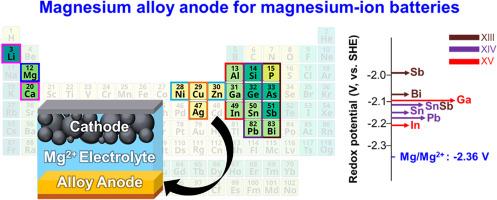当前位置:
X-MOL 学术
›
J. Magnes. Alloys
›
论文详情
Our official English website, www.x-mol.net, welcomes your
feedback! (Note: you will need to create a separate account there.)
Magnesium alloys as alternative anode materials for rechargeable magnesium-ion batteries: Review on the alloying phase and reaction mechanisms
Journal of Magnesium and Alloys ( IF 15.8 ) Pub Date : 2024-10-15 , DOI: 10.1016/j.jma.2024.09.018 Dedy Setiawan, Hyeonjun Lee, Jangwook Pyun, Amey Nimkar, Netanel Shpigel, Daniel Sharon, Seung-Tae Hong, Doron Aurbach, Munseok S. Chae
Journal of Magnesium and Alloys ( IF 15.8 ) Pub Date : 2024-10-15 , DOI: 10.1016/j.jma.2024.09.018 Dedy Setiawan, Hyeonjun Lee, Jangwook Pyun, Amey Nimkar, Netanel Shpigel, Daniel Sharon, Seung-Tae Hong, Doron Aurbach, Munseok S. Chae

|
Magnesium-ion batteries (MIBs) are promising candidates for lithium-ion batteries because of their abundance, non-toxicity, and favorable electrochemical properties. This review explores the reaction mechanisms and electrochemical characteristics of Mg-alloy anode materials. While Mg metal anodes provide high volumetric capacity and dendrite-free electrodeposition, their practical application is hindered by challenges such as sluggish Mg²⁺ ion diffusion and electrolyte compatibility. Alloy-type anodes that incorporate groups XIII, XIV, and XV elements have the potential to overcome these limitations. We review various Mg alloys, emphasizing their alloying/dealloying reaction mechanisms, their theoretical capacities, and the practical aspects of MIBs. Furthermore, we discuss the influence of the electrolyte composition on the reversibility and efficiency of these alloy anodes. Emphasis is placed on overcoming current limitations through innovative materials and structural engineering. This review concludes with perspectives on future research directions aimed at enhancing the performance and commercial viability of Mg alloy anodes and contributing to the development of high-capacity, safe, and cost-effective energy storage systems.
中文翻译:

镁合金作为可充电镁离子电池的替代负极材料合金化相和反应机理综述
镁离子电池 (MIB) 因其丰富、无毒和良好的电化学特性而成为锂离子电池的有前途的候选者。本文探讨了 Mg 合金负极材料的反应机理和电化学特性。虽然 Mg 金属负极提供高体积容量和无枝晶电沉积,但它们的实际应用受到 Mg²⁺ 离子扩散缓慢和电解质兼容性等挑战的阻碍。包含 XIII、XIV 和 XV 组元素的合金型阳极有可能克服这些限制。我们回顾了各种 Mg 合金,强调它们的合金化/脱合金反应机理、它们的理论能力以及 MIB 的实际方面。此外,我们还讨论了电解质成分对这些合金阳极的可逆性和效率的影响。重点是通过创新材料和结构工程来克服当前的限制。本文总结了对未来研究方向的看法,旨在提高镁合金负极的性能和商业可行性,并为开发高容量、安全和具有成本效益的储能系统做出贡献。
更新日期:2024-10-15
中文翻译:

镁合金作为可充电镁离子电池的替代负极材料合金化相和反应机理综述
镁离子电池 (MIB) 因其丰富、无毒和良好的电化学特性而成为锂离子电池的有前途的候选者。本文探讨了 Mg 合金负极材料的反应机理和电化学特性。虽然 Mg 金属负极提供高体积容量和无枝晶电沉积,但它们的实际应用受到 Mg²⁺ 离子扩散缓慢和电解质兼容性等挑战的阻碍。包含 XIII、XIV 和 XV 组元素的合金型阳极有可能克服这些限制。我们回顾了各种 Mg 合金,强调它们的合金化/脱合金反应机理、它们的理论能力以及 MIB 的实际方面。此外,我们还讨论了电解质成分对这些合金阳极的可逆性和效率的影响。重点是通过创新材料和结构工程来克服当前的限制。本文总结了对未来研究方向的看法,旨在提高镁合金负极的性能和商业可行性,并为开发高容量、安全和具有成本效益的储能系统做出贡献。


















































 京公网安备 11010802027423号
京公网安备 11010802027423号